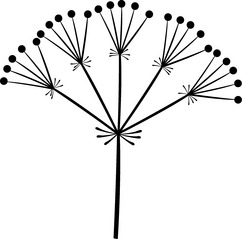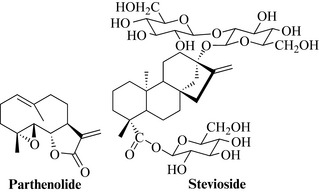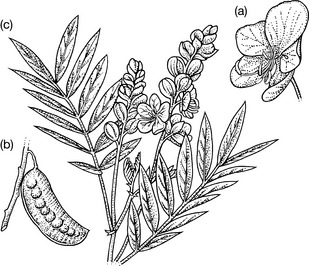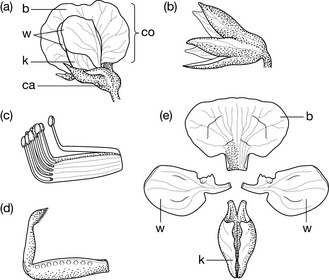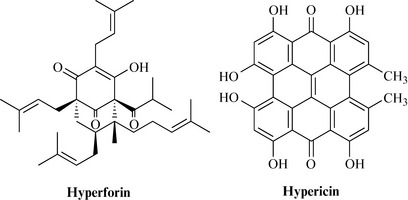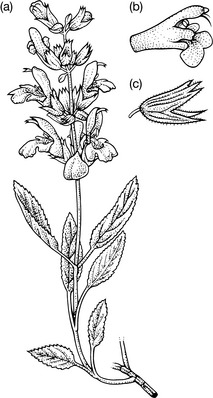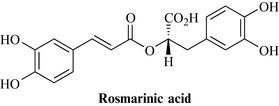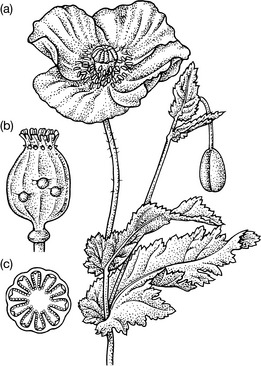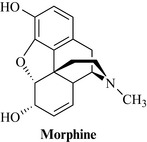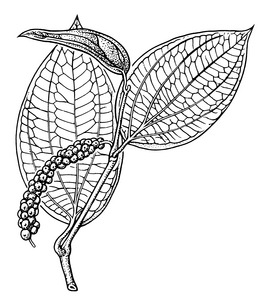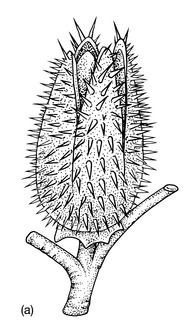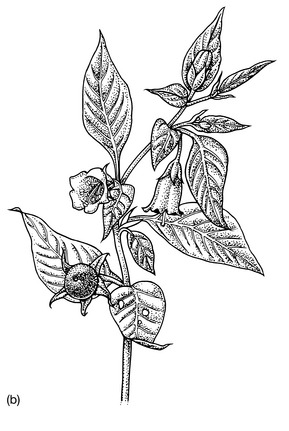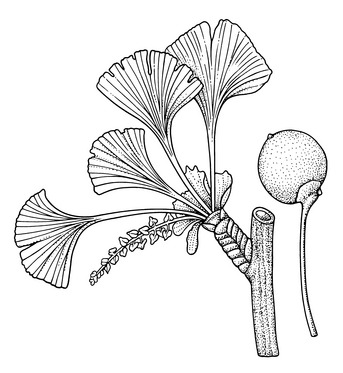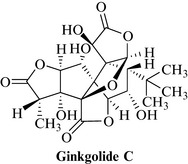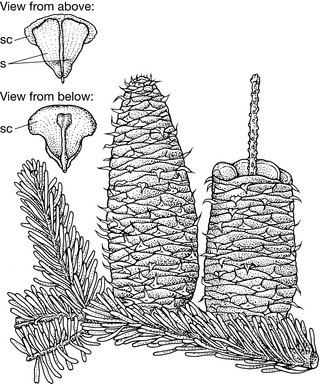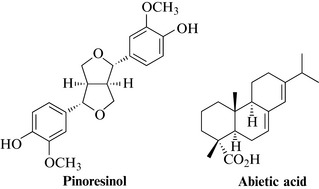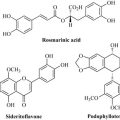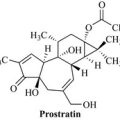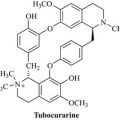Chapter 4 Families yielding important phytopharmaceuticals
Angiosperms (magnoliphyta)
Alliaceae (‘monocotyledoneae’)
Chemical characteristics of the family
The genus Allium is particularly well known for very simple sulphur-containing compounds, especially alliin and allicin (Fig. 4.1), which are thought to be involved in the reported pharmacological activities of the plant as a bactericidal antibiotic, in the treatment of arterial hypertension and in the prevention of arteriosclerosis and stroke.
Apiaceae (also called umbelliferae)
Important medicinal plants in the family (see p. 215-216, Chapter 14)
• Carum carvi L. (caraway), a carminative and also important as a spice
• Coriandrum sativum L. (coriander), a carminative and also important as a spice
• Foeniculum vulgare Miller (fennel), a mild carminative
• Levisticum officinale Koch (lovage), a carminative and antidyspeptic
• Pimpinella anisum L. (anise-fruit, wrongly called ‘seed’), an expectorant, spasmolytic and carminative.
Morphological characteristics of the family
This family of nearly exclusively herbaceous species is characterized by hermaphrodite flowers in a double umbel (Fig. 4.2); note that the closely related Araliaceae have a simple umbel. Typical for the family are the furrowed stems and hollow internodes, leaves with a sheathing base and generally a much divided lamina. The flowers are relatively inconspicuous, with two pistils, an inferior gynaecium with two carpels, a small calyx and generally a white to greenish corolla, with free petals and sepals.
Araliaceae
Important medicinal plants from the family
• Hedera helix L. [(common) ivy], used as a cough remedy
• Panax ginseng C. A. Meyer (ginseng), used as an adaptogene (a very ill-defined category) and to combat mental and physical stress [and sometimes replaced by Eleutherococcus (Acanthopanax) senticosus (Rupr. and Maxim) Maxim from the same family].
Asphodelaceae (‘monocotyledoneae’)
This family is often included in the Liliaceae (lily family).
Asteraceae – the ‘daisy’ family (also known as compositae)
Important medicinal plants from the family
• Arnica montana L. (arnica), used topically, especially for bruises
• Artemisia absinthum L. (wormwood or absinthium), used as a bitter tonic and choleretic
• Calendula officinalis L. (marigold), used topically, especially for some skin afflictions
• Cnicus benedictus L. (cnicus), used as a cholagogue (a bitter aromatic stimulant)
• Cynara scolymus L. (artichoke), used in the treatment of liver and gallbladder complaints and several other conditions
• Echinacea angustifolia DC., E. pallida Nuttall and E. purpurea (L.) Moench (Cone flower), now commonly used as an immunostimulant
• Matricaria recutita L. (chamomille/camomille; several botanical synonyms are also commonly used, including Chamomilla recutita and Matricaria chamomilla) (see Chapter 14, p. 208).
• Tussilago farfara L. (coltsfoot), a now little used expectorant and demulcent.
Chemical characteristics of the family
A typical chemical trait of this family is the presence of polyfructanes (especially inulin) as storage carbohydrates (instead of polysaccharides) in perennial taxa. Inulin-containing drugs are used for preparing malted coffee (e.g. from the rootstocks of Cichorium intybus, chicory). In many taxa, some segments of the family accumulate sesquiterpene lactones (typically with 15-carbon atoms such as parthenolide; Fig. 4.4), which are important natural products responsible for the pharmacological effects of many botanical drugs such as Chrysanthemum parthenium (feverfew) and Arnica montana (arnica). Polyacetylenic compounds (polyenes), and essential oil, are also widely distributed. Some taxa accumulate pyrrolizidine alkaloids, which, for example, are present in Tussilago farfara (coltsfoot) in very small amounts. Many of these alkaloids are known for their hepatotoxic effects. Other taxa accumulate unusual diterpenoids; the diterpene glycoside stevioside (Fig. 4.4), for example, is of interest because of its intensely sweet taste.
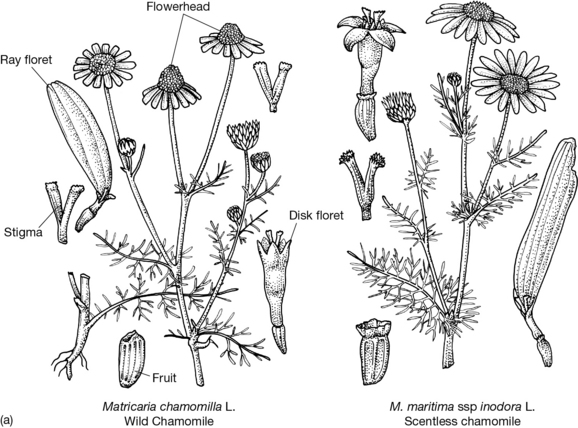
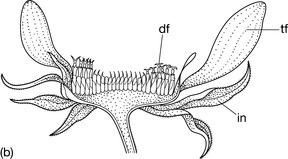
Fig. 4.3 (a) Two members of the genus Matricaria. (Left) Matricaria chamomilla L. is aromatic and used medicinally. (Right) Matricaria maritima L. subsp. inodora Schultz [= Tripleurospermum perforatum (Mérat) Wagenitz], also known as Matricaria inodora, is not aromatic and is not used medicinally. The illustration shows typical morphological differences in these two species, such as the form of the flower heads and the fruit, but it also shows how similar the two species are in many other characteristics. From Fitch (1924). (b) Schematic of typical flower heads (a capitulum) of the Asteraceae (compositae). df, disk flowers; tf, tubular flowers; in, involucre, from Brimble (1942).
Caesalpiniaceae
Fabaceae
Important medicinal plants from the family
• Cytisus scoparius (L.) Link (common or Scotch broom), which yields sparteine (formerly used in cardiac arrhythmias, as an oxytoxic, and in hypotonia to raise blood pressure)
• Glycyrrhiza glabra L. (liquorice), used as an expectorant and for many other purposes
• Melilotus officinalis L. (melilot or sweet clover); the anticoagulant drug warfarin was developed from dicoumarol, first isolated from spoiled hay of sweet clover
• Physostigma venenosum Balfour (Calabar bean), a traditional West African arrow poison, which contains the cholinesterase inhibitor physostigmine, used as a myotic in glaucoma, in postoperative paralysis of the intestine and to counteract atropine poisoning.
Morphological characteristics of the family
This family is characterized by a large number of derived traits. Most of the taxa of this family are herbaceous, sometimes shrubby and only very rarely trees. Typically, the leaves are pinnate and sometimes the terminal one is modified to form a tendril, used for climbing. Bipinnate leaves are not found in this family. The five sepals are at least basally united. The corolla is formed of five petals and has a very characteristic butterfly-like shape (papilionaceous), with the two lower petals fused and forming a keel-shaped structure, the two lateral ones protruding on both sides of the flower and the largest petal protruding above the flower, being particularly showy. The androecium of ten stamens generally forms a characteristic tubular structure with at least nine out of ten of the stamens forming a sheath. Normally, the fruit are pods, containing beans (technically called legumes) with two sutures, which open during the drying of the fruit (Fig. 4.6).
Chemical characteristics of the family
This large family is characterized by an impressive phytochemical diversity. Polyphenols (especially flavonoids and tannins) are common, but from a pharmaceutical perspective various types of alkaloids are probably the most interesting and pharmaceutically relevant groups of compounds. In the genera Genista and Cytisus (both commonly called broom) as well as Laburnum, quinolizidine alkaloids, including cytisine and sparteine (Fig. 4.7), are common. The hepatotoxic pyrrolizidine alkaloids are found in this family (e.g. in members of the genus Crotolaria).
Hypericaceae
Chemical characteristics of the family
The former name Guttiferae is an important indicator of a characteristic chemical feature: the presence of resins, balsam and other glands containing excretory products. For example, the hypericin glands, with a characteristic red colour, are present especially in the flowers and contain naphthodianthrones, including hypericin (Fig. 4.8) and pseudohypericin, which are characteristic for some sections of the genus. Typical for the family in general are also xanthones (found nearly exclusively in this family and in the Gentianaceae). The genus is known to accumulate flavonoids and their glycosides (rutoside, hyperoside), as well as hyperforin (Fig. 4.8) and its derivatives, which are derived from the terpenoid pathway.
Lamiaceae
Important medicinal plants from the family
• Lavandula angustifolia Miller (lavender), a mild carminative and spasmolytic
• Melissa officinalis L. (balm), a mild sedative, carminative and spasmolytic
• Mentha arvensis L. var. piperascens Malinvand (Japanese mint), yields a commonly used essential oil (e.g. for respiratory problems)
• Mentha × piperita L. (peppermint), a commonly used carminative and spasmolytic and a hybrid between M. spicata L. and M. aquatica L. (see Chapter 14, p. 214-215)
• Mentha spicata L. (spearmint), commonly used in toothpaste and chewing gum, with mild carminative effects
• Rosmarinus officinalis L. (rosemary), a carminative and spasmolytic
• Salvia officinalis L. (sage), used as a topical antiseptic (gargling) and orally as a carminative and spasmolytic
• Thymus vulgaris L. (thyme), a carminative and spasmolytic.
Chemical characteristics of the family
Essential oil in the epidermal glands is very common. Some segments of the family are known to accumulate monoterpenoid glycosides (iridoids). Many species also accumulate rosmarinic acid and other derivatives of caffeic acid. Rosmarinic acid (Fig. 4.10) is of some pharmaceutical importance because of its non-specific complement activation and inhibition of the biosynthesis of leukotrienes (leading to an anti-inflammatory effect), as well as its antiviral activity.
Palmaceae (Arecaceae, Palmae, ‘Monocotyledoneae’)
Papaveraceae
Chemical characteristics of the family
The laticifers (or latex vessels) are rich in isoquinoline alkaloids, including morphine (Fig. 4.12), papaverine, codeine, thebaine and noscapine. Some of these alkaloids are typical benzylisoquinoline alkaloids (papaverine, noscapine); others are chemically modified and have two additional ring systems (morphinane-type skeleton).
Piperaceae
Important medicinal plants from the family
• Piper methysticum Forster f. (kava-kava), traditionally used as a mild stimulant in Oceania and now used for conditions of nervous anxiety; recent reports of liver toxicity has resulted in withdrawal in many countries
• Piper nigrum L. (black and white pepper), occasionally used in rubefacient preparations and as a spice.
Poaceae (‘Monocotyledoneae’)
Rhamnaceae
Rubiaceae
Rutaceae
Important medicinal plants from the family
• Pilocarpus jaborandi Holmes and Pilocarpus spp. (pilocarpus), for the isolation of pilocarpine, which is used in ophthalmology
• Ruta graveolens L. (rue), formerly widely used as an emmenagogue and spasmolytic, shows strong phototoxic side effects
• Many species (especially of the genus Citrus) are aromatic and used as foods as well as in pharmacy and perfumery.
Chemical characteristics of the family
Essential oil is common in many taxa (Citrus, Ruta) and can be found in lysigenous secretory cavities in the parenchyma and pericarp. Alkaloids are also frequently found, especially benzyltetrahydroisoquinoline, acridone and imidazole types (pilocarpine; Fig. 4.14). The acridone alkaloids have so far only been reported from the Rutaceae. Other groups of natural products typically encountered are furano- and pyranocoumarins (e.g. bergapten from Citrus aurantium subsp. bergamia, used to flavour Earl Grey tea), as well as simple coumarins.
Solanaceae
Chemical characteristics of the family
Typical for the family are alkaloids, especially of the tropane, nicotine and steroidal type (Fig. 4.16). Many taxa are characterized by oxalic acid, which often forms typical structures (e.g. sand-like in Atropa belladonna, irregular crystals in Datura stramonium).
Zingiberaceae (‘monocotyledoneae’)
Important medicinal plants from the family
• Curcuma zanthorrhiza Roxburgh (Temu lawak, Javanese turmeric)
• Curcuma longa L. (syn. C. domestica, turmeric), a commonly used spice and popular remedy used, for example, for inflammatory and liver diseases, and in most Asian medical systems for a large variety of illnesses
• Elettaria cardamomum (L.) Maton (cardamom), which is mostly used as a spice but also as a medicine
• Zingiber officinale Roscoe (ginger), used for a large variety of illnesses, including travel sickness, respiratory and gastrointestinal disorders.
Chemical characteristics of the family
This family is one of the few families of the former Monocotyledons which is rich in essential oil with terpenes such as borneol, camphor and cineole (all oxygen-containing monoterpenes), camphene, pinene (monoterpenes) and zingiberene (a sesquiterpene), as well as phenylpropanoids (cinnamic acid derivatives) (Fig. 4.17). Typically, these compounds accumulate in oil cells, an important microscopical characteristic of the rhizomes of the Zingiberaceae.
Gymnosperms
Ginkgoaceae
Chemical characteristics of the family
The most important and a unique group of natural products are the ginkgolides (Fig. 4.19), which are unusual two-ringed diterpenoids with three lactone functions. Biflavonoids and glycosylated flavonoids are other groups of typical natural products.
Chemical characteristics of the family
The best known pharmaceutical products from this family are essential oils and balsams, which are typically found in the schizogenic excretion ducts of the leaves as well as in the excretion pores of the wood and bark. Both are rich in monoterpenoids such as α-pinene and borneol. Mixtures of oil and resin from these species are called turpentine, while the resinous part is called colophony and is particularly rich in terpenoids (including diterpenoids such as abietic acid). Other widely reported groups of compounds from members of this family are flavonoids, condensed tannins and lignans (e.g. pinoresinol) (Fig. 4.21).
Evans W.C. Trease and Evans’ pharmacognosy, fifteenth ed. London: WB Saunders; 2000.
Heywood V.H. Flowering plants of the world. London: Batsford; 1993.
Judd W.S., Campbell C.S., Kellogg E.A., et al. Plant systematics. A phylogenetic approach, second ed. Sunderland, MA: Sinauer; 2002.
Mabberly D.J. The plant book. Cambridge: Cambridge University Press; 1990.
Raven P.H., Evert R.F., Eichhorn S.E. Biology of plants, sixth ed. New York: WH Freeman; 1999.
Robbers J.E., Speedie M.K., Tyler V.E. Pharmacognosy and pharmacobiotechnology. Baltimore: Williams & Williams; 1996.
Sitte P., Ziegler H., Ehrendorfer F., Bresinsky A. Lehrbuch der Botanik (‘Strasburger’). 34 Aufl. Stuttgart: Gustav Fischer Verlag, 1997.


